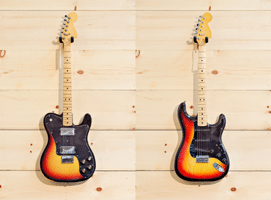
I’ll bet you’re thinking about purchasing a Telecaster or a Stratocaster guitar but are trying to decide which way you want to go. In this Tele Vs Strat sound article, I’ll help you fill in the blanks, so you can get the guitar that works best for you!
You can use the table of contents below to take you to the area that interests you. Click on the little box to open it, and then click on the section of the article you want to read, or you can read from start to finish if you want the full Tele vs. Strat experience!
Keep on reading to learn more!

What Determines A Guitar’s Tone?
When you’re in the market for a guitar, you’re primarily after a “look” and a “sound,” not necessarily in that order. I’ve seen people in a music store pick out an electric guitar for its shape and color, sometimes without even plugging it in!
When I bought my first guitar at Sears (a Silvertone Jazz Master copy) in the late 1960s, I’ll admit that I did the same thing! Since I had no idea how to play it, I thought it sounded great when I got it home.
Whether this is your first or 50th guitar, you should be concerned about tone. Here are some of the main things that can determine the sound of an electric guitar.
- Neck Tonewood
- Body Tonewood
- Strings
- Pickups
- Bridge
- Age of the Guitar (new vs. vintage)
- Your Playing Style and Skill Level
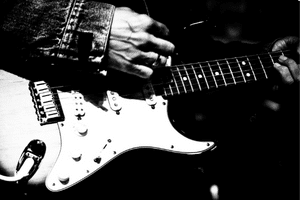
Fundamental Tonal Differences In Tele Vs Strat Tone
There are some significant tone differences between a Tele and a Strat!
Neck
The Stratocaster has a larger headstock than the Telecaster. This may have initially been an attempt to set the Stratocaster apart visually from the Telecaster. However, the extra wood can help enhance the guitar’s sustain, especially on the late 60s to early 70s models, which have the largest Strat headstocks.
The maple necks on the vast majority of Teles and Strats, apart from the headstock, are very similar and therefore have the same tonal characteristics.
Body
The bodies of each guitar have significant shape and thickness differences. Also, alder or ash may be used in body construction. Alder has a generally more resonant and well-balanced tone, whereas ash tends to have a sharper attack in the higher frequencies.
Electronics
Both types of guitars have very different electronics. The Tele design added a second pickup to the original Fender Esquire single-pick guitar, whereas the Strat added a third pickup for even more tonal variation.
What really stands out with the Telecaster is the bridge pickup, which is larger than the Strat pickup and mounted in the Tele’s bridge plate to give it a sharper and more powerful tone.
The pickup selector switch on the Tele can give you the sound of each of the two pickups separately or in combination. Strat pickups are wired to be selected independently (3-position switch) on older models and in combination (5-position switch) on newer models.
The Tele can give you one out-of-phase sound by combining the neck and bridge pickups together. On the other hand, the Strat can provide you with two out-of-phase sounds by combining the neck and middle pickups or the middle and bridge pickups.
Both guitars have a master volume control. The Tele has one tone control, whereas the Strat has two.
Therefore the Strat gives you more tonal combinations than the Tele.
Hardware
The main hardware difference between the Tele and the Strat is the bridge and string saddle design.
Teles
Teles have a large bridge plate that houses the bridge pickup. The stings can go through the guitar’s body or terminate in the bridge plate. The string through the body (vintage) design gives the guitar more sustain.
Telecaster guitars come with three bridge saddles (vintage design) or six individual saddles. Saddles come in a variety of materials, but mostly steel or brass. I find that 3-saddle Teles with a string through the body design tend to produce the warmest tone and best sustain, even though they can be more challenging to intonate than individual saddle bridges.
Strats
A Stratocaster’s vibrato bridge is made more for function than tone. It is not permanently fixed to the guitar’s body like a Telecaster. It is designed to be moved up and down with a whammy bar by way of its attachment to a series of springs in the tremolo cavity on the rear of the body. The number of springs used can vary but is typically three or five.
Additionally, the bridge can be attached to the body with six screws (vintage design) or by way of a two-point fulcrum design. Each of these two types adds to the overall tone of the guitar.
The bridge can be set to move up and down in both directions (float) or sit flat against the body (fixed). Some Strats have a “hardtail” (non-vibrato) bridge, which does not have a whammy bar, tremolo cavity, or springs.
Therefore, a Strat’s bridge is significantly more instrumental in determining the guitar’s overall tone than a Tele.
Eric Clapton “blocks” his tremolo by placing a wooden block inside the tremolo cavity to keep the bridge perfectly immobilized. He prefers this setup to a hardtail bridge because he feels the tremolo springs add a particular tonal character to the guitar’s overall sound, even if they can’t be used.
Keep On Reading To Learn More About Each Topic

Tonal Advantages
Here is a summary of the main tonal advantages of the Telecaster and Stratocaster guitars.
Telecaster
- Classic “Country” sound
- Better tuning stability
- Bridge typically has better tone and sustain
Stratocaster
- Classic “Rock and Metal” sounds
- Three pickups
- Two out-of-phase sounds (neck + middle and middle + bridge pickups)
- More tonal flexibility

Tonal Disadvantages
Here is a summary of the main tonal disadvantages of the Telecaster and Stratocaster guitars.
Telecaster
- Two pickups
- One out-of-phase sound (neck + bridge pickup)
- Less tonal flexibility
Stratocaster
- More challenging to keep in tune
- Tremolo bridge can detract from tone and sustain

Design Similarities And Differences
This table compares a typical Telecaster to a typical Stratocaster.
Both types of guitars can vary in design, especially with regard to pickup type and configuration.
| Item | Telecaster | Stratocaster |
|---|---|---|
| Neck | ||
| Tonewood | Maple | Maple |
| Fingerboard | Maple or rosewood | Maple or rosewood |
| Fingerboard Radius | 7.5 to 12 inches (9.5 average) | 7.5 to 12 inches (9.5 average) |
| Frets | 21 to 22 frets | 21 to 22 frets |
| Scale Length | 25.5 inches | 25.5 inches |
| Attachment To Body | Bolt-On | Bolt-On |
| Body | ||
| Style | Single cutaway | Double cutaway |
| Tonewood | Alder or ash | Alder or ash |
| Electronics | ||
| Pickups | 2 Single-coil | 3 Single-coil |
| Controls | 1 volume and 1 tone, 3-way switch | 1 volume and 2 tone, 5-way switch |
| Hardware | Bridge plate with 3 or 6 saddles | Synchronized tremolo |
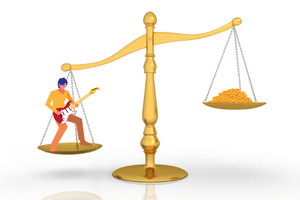
Are Both Guitars Legit?
Absolutely! The Tele and Strat are both fantastic choices, no matter what type of music you are interested in playing. For a Fender electric, these are the most played models, and for good reason.
Teles and Strats have been time-tested over the years. They both offer tremendous value for the money in terms of sound, playability, and versatility!

Getting Both Tele & Strat Sounds!
Both guitars have some overlap in the tones they can produce, but a Tele and a Strat each have their unique sound.
Once you learn the sound of both guitars, it’s unlikely that you would confuse one for the other.
The perfect solution is to buy both a Tele and a Strat if you want it all.
When I was in high school, I started with a Strat and had to have it in Olympic White with a rosewood fingerboard, just like the one Jimi Hendrix played. All the while, I was very intrigued with the sound of the Telecaster and played one every chance I got.
Eventually, I broke down and bought a Red Custom Tele with a maple neck. Although I still favor Strats, I never stopped playing the Tele. Both guitars are so unique that I change back and forth constantly.
The Player Plus Nashville Telecaster – A Novel Solution!
It didn’t take long before Country players in Nashville started modding their Teles by adding a middle pickup to get closer to a Strat sound!
If you want a Tele that honors this tradition, you should have a look at the Fender Player Nashville Tele!
It has a noiseless Tele pickup in the neck and bridge positions and a noiseless STRAT pickup in the middle position. A push-pull tone control engages the neck pickup in switch positions 1 & 2.
The push-pull tone switch gives you seven different tonal opportunities (the standard five 3-pickup combinations plus bridge & neck pickup plus all three pickups).
The bridge and neck pickup combo gives your playing an “undefinable” depth that’s great for rhythm and lead work.
Using all three pickups together gives the guitar a very balanced and “Strat-like” sound.
It’s a great compromise to getting both guitars and produces a variety of sounds that a Tele or Strat can’t duplicate.

Does The Kind Of Music You Play Matter?
Actually, when it comes right down to it, you can play any type of music on a Tele or a Strat. Most players associate Teles with country music and Strats with rock, but these guitars are versatile enough to play any genre.
If I say Buck Owens, Marty Stuart, or Brad Paisley, you’ll probably say “Tele.”
However, Muddy Waters played blues on his red Tele, and Jimmy Page recorded the entire Led Zeppelin I album on his famous “Dragon” Tele. Ted Green played the most amazing jazz on a Telecaster.
If I say Jimi Hendrix, Eric Clapton, or Jeff Beck, you’ll probably say “Strat.”
However, Bill Carson played country & western while Buddy Holly and Ritchie Valens both played 50s pop and rockabilly, all on a Strat.
So you can choose the type of guitar that you think sounds best for the kind of music you play. Both the Tele and the Strat are versatile enough to adapt to any genre.
Titans Of The Telecaster
Here are some other famous Tele players.
- Albert Collins
- Vince Gill
- Steve Cropper
- James Burton
- Keith Richards
- Albert Lee
- Conway Twitty
- Roy Buchanan
- John 5
- Mike Bloomfield
- Bruce Springsteen
- Keith Urban
- Redd Volkaert
- Jim Root
- Greg Koch
Stratocaster Superstars
Do you recognize these Sultans of the Stratocaster?
- Buddy Guy
- Dick Dale
- David Gilmour
- Ritchie Blackmore
- Mark Knopfler
- Stevie Ray Vaughan
- Robert Cray
- Eric Johnson
- Dave Murray
- Yngwie Malmsteen
- Joe Bonamassa
- The Edge
- Rory Gallagher
- Hank Marvin
- Bonnie Raitt

Which Guitar Is Better For Beginners?
There is no clear choice of Tele versus Strat for beginning players; however, here are some things to consider.
If the guitar is for a child, a smaller size might be the way to go. They are available in ½ size and 3/4 size. Adults should go with a full-size instrument.
A Tele might be a good starting guitar since there is no vibrato bridge, making it easier to keep in tune. If you want to begin with a Strat, consider removing the whammy bar until you get the hang of playing basic stuff.
I would strongly recommend beginning with a Fender Squier guitar if cost is an issue. Teles and Strats are available in both the Squier Bullet and Squier Affinity series. The main difference is that the Bullet Series is cheaper but less durable than the Affinity Series.
The Bullet Series sells for about $200 and includes a Tele, Strat, and a Strat with a humbucking pickup in the bridge position (S-S-H).
The Affinity Series Sells for about $300 and includes a Tele, Strat, and a Tele with two humbucking pickups (H-H).
If you like the sound of one guitar more than the other or think a Tele is better for country, and a Strat is better for rock, feel free to use that as your choice criteria.
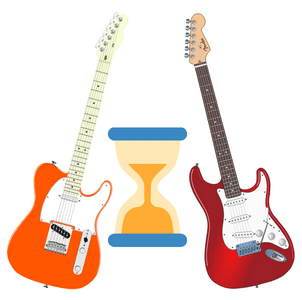
Brief History Of The Tele And Strat
The Telecaster-model guitar was first sold in 1951, so it predated the Stratocaster. It was actually around even earlier, first as the “Broadcaster” and then as the “Nocaster.” The Broadcaster guitar came under a legal trademark dispute, for which Gretsch claimed it infringed on the name of their “Broadkaster” drum kit.
To settle the dispute, Fender removed the Telecaster name by clipping off a piece of the headstock decal, which was sold as the so-called “Nocaster.” Nocaster guitars were sold until it was renamed the Telecaster.
The Telecaster was essentially the first commercially successful solid-body electric guitar. Since rock and roll was still in its infancy, the Telecaster was adopted by country music players, and its twangy sound was a perfect fit.
The Stratocaster was designed as an upgrade to the sound and playability of the Telecaster. It had a radical new body shape with double cutaways for better access to higher notes and comfort contours on the front and back of the body. The guitar featured a middle pickup and a newly designed “tremolo system” bridge.
The three-pickup design with two tone controls gave it a wider range of tonal possibilities. Most interesting of all was the vibrato bridge that allowed players to bend notes and chords easily.
When the Strat hit the market in 1954, it looked like it was ready for the “jet age.” The Strat became a favorite of rock musicians, as the whammy bar brought previously unavailable sounds to the stage, especially in the hands of players like Jimi Hendrix.

Fender Company Profile
Unless you just started playing the guitar today, you are undoubtedly familiar with the Fender brand. These guitars have literally helped define rock n’ roll and blues history. Their original factory was in Fullerton, California.
Fender guitars are now made in many parts of the world, with the American-made and Custom Shop guitar lines still made with pride in the USA.
Fender has also led the way with amplifiers. Their “K&F” (Doc Kauffman and Leo Fender) series were the very first Fender amps, made by the K&F Manufacturing Corporation. These amps formed the basis of the Woodie, Tweed, Blonde, Brownface, Blackface, and Silverface series.
Fender makes an extensive line of pickups for all their guitars and bass guitars. Their Custom Shop pickups are hand-wired with hand-beveled magnetic pole pieces and period-correct wire and bobbins.

Frequently Asked Questions
Here are some of the questions I get asked about Telecasters and Stratocasters.
If your question does not appear here, please put it in the comments, and I will get right back to you with an answer.
Is A Strat Easier To Play Than A Tele?
Not really. They both require the development of specific skills, but a Strat can be more challenging to keep in tune because of the vibrato bridge. If you float a Strat bridge so that strings can be bent up and down with the whammy bar, tuning can be even more problematic.
Can You Make A Telecaster Sound Like A Strat?
A Tele can mimic certain Strat sounds, but each guitar has its own specifically identifiable tones. The classic 2-pickup configuration of a Tele cannot precisely match the sound of a Strat’s middle pickup or the out-of-phase sounds that can be made with it.
Also, the Telecaster can not do string bends the same way a Strat can because the Tele does not have a vibrato bridge.
Is A Strat More Versatile Than A Tele?
On-the-overall, yes. The 3-pickup configuration and vibrato bridge make it more versatile than a Tele.
Did Jimmy Page Use A Telecaster?
Yes, Jimmy Page used his famous “Dragon” Telecaster to record Led Zeppelin I and onstage from 1968 to 1969. After that, he switched to a Les Paul guitar.
Can A Tele Sound Like A Les Paul?
A Telecaster with two humbucking pickups can approximate the sound of a Les Paul. Still, it can’t copy its overall tone and natural sustain, primarily due to the difference in tonewoods and guitar body thickness.
Why Is It Called A Telecaster?
The name “Telecaster” was coined by Don Randall at Fender by merging the word Broadcaster with the word television after Broadcaster guitars were changed to “Nocaster” guitars by removing the name on the headstock decal.
Television sets were a new, high-tech, and trendy electronic device, and it was thought to be a good marketing ploy.
Why Is It Called A Stratocaster?
It is commonly believed that the guitar got its name from the word “Stratosphere,” which comprises a part of the earth’s atmosphere, to capitalize on the popularity of the first jet airliners of the 1950s.
It was conceived by Don Randall to help make the Stratocaster Fender’s new flagship electric guitar. The Strat was expected to be the replacement for the Telecaster, but the Tele retained its popularity, especially among country players.
Are Squiers Good Guitars?
Yes, Fender developed the Squier line as an economical version of their most popular models, aimed primarily at beginning students and players on a budget.
Although they are made with lower quality materials, they play and sound good enough to gig with and have even been used by professional players such as Jeff Healey and Jack White.

Final Thoughts
I hope you found this Tele Vs Strat sound article valuable!
Remember, there are many determinants of a guitar’s tone, not just the brand name or guitar model. The neck and body tonewood, pickups, hardware, and the strings you use are all important.
There is no definite advantage of playing a Tele over a Strat and vice versa. They both have their own distinct sound, and each can make you play differently to a certain extent. The only way to get the best of both worlds is to buy one of each guitar.

Your choice of playing a Tele or Strat will not lock you into a musical genre. They are both highly versatile instruments, and what you can play is only limited by your imagination and skill.
Related Article ➡ Can A Strat Sound Like A Les Paul? – Trade Secrets Revealed!

Tell Me What You Think
Please leave a comment below if you enjoyed this article, have any questions about strat sound vs tele sound, or want to give your point of view. I will be happy to help you.
- Do you play a Tele or a Strat? Why or why not?
- What do you like the most or least about each guitar?
- If you could only have one guitar, what would you get? Why?
- After reading this article, are you considering buying a Tele or a Strat?


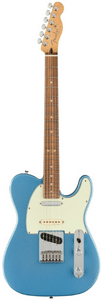

OK – so I am left handed, and have always wanted to learn to play the guitar. I would probably want to learn to play soft rock music in the long run!
Would you be able to advise me as to which guitar might be better for a left handed beginner, or should I focus on acoustic guitars since they can be strung left handed.
Hi, Anna
Thank You for your comments!
Most guitar companies make electric and acoustic guitars for left-handed players. If you want to string a right-handed electric guitar “left-handed” (to play it upside down), you will also need to have the guitar nut turned upside down so that the string order can be reversed.
It can be more complicated to string an acoustic guitar upside down because you may need to also make some changes to the guitar’s bridge, not just the nut.
A certified guitar technician will be able to do this for you.
The easiest approach for a beginner would be to buy a left-handed (ready to play) electric guitar so that everything else on the guitar (body cutouts, controls, etc.) is in the proper orientation.
The most cost-effective approach would be to buy a cheap right-handed electric guitar and then reverse the nut and strings so that you can play it upside down.
For “soft rock,” I recommend starting with a Fender Stratocaster or Telecaster guitar from their Squire Bullet or Affinity line.
Frank
I truly enjoyed reading your post, and I learned a few things as well! I guess one question I have is how long can a guitar last. I have heard of people playing violins that are centuries old. Does a guitar eventually wear out? How often do they need to be replaced?
I can appreciate that the tone of the guitar in part, can depend on the type of wood. I can sit and listen to a good guitarist for a long time!
Hi, Carolyn
Thank You for your comments!
If guitars are kept in the proper storage conditions, they can last for centuries. See my article, “How to store a guitar – Avoid these mistakes to keep it safe.”
Some of the classical guitars have been around quite a while. The Smithsonian museum has some made by Antonio de Torres in the 19th century.
For electric guitars, it’s easy to find models made as far back as the late 1940s and the early 1950s. These vintage electric guitars are quite playable and sell for quite a bit of money. Electronic parts, like a volume control, may need to be cleaned or replaced, but replacing them will lower the guitar’s value.
Frank